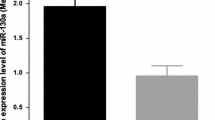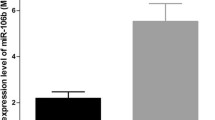Abstract
MicroRNAs are predicted to play fundamental roles in the tumorigenesis of hepatocellular carcinoma (HCC). MiR-375 is frequently downregulated in HCC and acts as a tumor suppressor by targeting multiple oncogenes. The objective of this study was to evaluate miR-375 expression and its relevance to the prognosis of HCC. MiR-375 expression was measured in cancerous tissues using qRT-PCR and dichotomized based on a median cutoff. The association between miR-375 expression and clinicopathological parameters and prognosis was subsequently determined. Expression levels of miR-375 were detected in a cohort of 38 HCC patients who underwent curative surgery. No significant correlations were observed between miR-375 expression and clinicopathological parameters, such as gender, age, performance status, preoperative serum AFP level, histological grade, HBV-DNA copy number, ascites, cirrhosis, tumor size, number of tumor nodules, and macrovascular invasion. However, miR-375 expression differs across CLIP scores significantly (p < 0.05). A trend toward poorer disease-free survival (DFS) was observed in patients with lower miR-375 expression compared to those with higher miR-375 expression (p = 0.307). Multivariate analysis demonstrated that low miR-375 expression was an independent prognostic predictor for progression (p = 0.032, risk ratio 3.273). Subgroup analysis revealed that low expression of miR-375 was significantly associated with adverse DFS in patients with poorly differentiated histology, higher serum AFP level (≥400 ng/ml), and advanced tumor stage (CLIP score 1∼3) (p = 0.017, 0.009, and 0.024, respectively). Our study demonstrates that miR-375 expression is significantly correlated with DFS and may be a potential prognostic biomarker of disease progression in HCC.



Similar content being viewed by others
Abbreviations
- HCC:
-
Hepatocellular carcinoma
- HBV:
-
Hepatitis B virus
- qRT-PCR:
-
Quantitative reverse transcription polymerase chain reaction
- AFP:
-
Alpha-fetoprotein
- ECOG PS:
-
The Eastern Cooperative Oncology Group Performance Status
- CLIP:
-
The Cancer of the Liver Italian Program
- TACE:
-
Transcatheter hepatic arterial chemoembolization
- DFS:
-
Disease-free survival
- OS:
-
Overall survival
References
Kamangar F, Dores GM, Anderson WF. Patterns of cancer incidence, mortality, and prevalence across five continents: defining priorities to reduce cancer disparities in different geographic regions of the world. Clin Oncol. 2006;24(14):2137–50.
Ferlay J, Shin HR, Bray F, Forman D, Mathers C, Parkin DM. Estimates of worldwide burden of cancer in 2008: GLOBOCAN 2008. Int J Cancer. 2010;127(12):2893–917.
Jemal A, Bray F, Center MM, Ferlay J, Ward E, Forman D. Global cancer statistics. CA Cancer J Clin. 2011;61(2):69–90.
Llovet JM, Bruix J. Novel advancements in the management of hepatocellular carcinoma in 2008. J Hepatol. 2008;48 Suppl 1:S20–37.
Llovet JM, Burroughs A, Bruix J. Hepatocellularcarcinoma. Lancet. 2003;362(9399):1907–17.
Llovet JM, Fuster J, Bruix J. Intention-to-treat analysis of surgical treatment for early hepatocellular carcinoma: resection versus transplantation. Hepatology. 1999;30(6):1434–40.
European Association For The Study Of The Liver. European Organisation For Research And Treatment Of Cancer. EASL-EORTC clinical practice guidelines: management of hepatocellular carcinoma. J Hepatol. 2012;56(4):908–43.
Bartel DP. MicroRNAs: genomics, biogenesis, mechanism, and function. Cell. 2004;116(2):281–97.
Murakami Y, Yasuda T, Saigo K, Urashima T, Toyoda H, Okanoue T. ShimotohnoK. Comprehensive analysis of microRNA expression patterns in hepatocellular carcinoma and non-tumorous tissues. Oncogene. 2006;25(17):2537–45.
Ladeiro Y, Couchy G, Balabaud C, Bioulac-Sage P, Pelletier L, Rebouissou S, et al. MicroRNA profiling in hepatocellular tumors is associated with clinical features and oncogene/tumor suppressor gene mutations. Hepatology. 2008;47(6):1955–63.
Budhu A, Jia HL, Forgues M, Liu CG, Goldstein D, Lam A, et al. Identification of metastasis-related microRNAs in hepatocellular carcinoma. Hepatology. 2008;47(3):897–907.
Fornari F, Gramantieri L, Ferracin M, Veronese A, Sabbioni S, Calin GA, et al. MiR-221 controls CDKN1C/p57 and CDKN1B/p27 expression in human hepatocellular carcinoma. Oncogene. 2008;27(43):5651–61.
Pineau P, Volinia S, McJunkin K, Marchio A, Battiston C, Terris B, et al. miR-221 overexpression contributes to liver tumorigenesis. Proc Natl Acad Sci U S A. 2010;107(1):264–9.
Fornari F, Gramantieri L, Giovannini C, Veronese A, Ferracin M, Sabbioni S, et al. MiR-122/cyclin G1 interaction modulates p53 activity and affects doxorubicin sensitivity of human hepatocarcinomacells. Cancer Res. 2009;69(14):5761–7.
Coulouarn C, Factor VM, Andersen JB, Durkin ME, Thorgeirsson SS. Loss of miR-122 expression in liver cancer correlates with suppression of the hepatic phenotype and gain of metastatic properties. Oncogene. 2009;28(40):3526–36.
Tsai WC, Hsu SD, Hsu CS, Lai TC, Chen SJ, Shen R, et al. MicroRNA-122 plays a critical role in liver homeostasis and hepatocarcinogenesis. J Clin Invest. 2012;122(8):2884–97.
Poy MN, Eliasson L, Krutzfeldt J, Kuwajima S, Ma X, Macdonald PE, et al. A pancreatic islet-specific microRNA regulates insulin secretion. Nature. 2004;432(7014):226–30.
Liu AM, Poon RT, Luk JM. MicroRNA-375 targets Hippo-signaling effector YAP in liver cancer and inhibits tumor properties. Biochem Biophys Res Commun. 2010;394(3):623–7.
He XX, Chang Y, Meng FY, Wang MY, Xie QH, Tang F, et al. MicroRNA-375 targets AEG-1 in hepatocellular carcinoma and suppresses liver cancer cell growth in vitro and in vivo. Oncogene. 2012;31(28):3357–69.
Zhao J, Wang W, Huang Y, Wu J, Chen M, Cui P, et al. HBx elevates oncoprotein AEG-1 expression to promote cell migration by downregulating miR-375 and miR-136 in malignant hepatocytes. DNA Cell Biol. 2014;33(10):715–22.
Yin J, Hou P, Wu Z, Wang T, Nie Y. Circulating miR-375 and miR-199a-3p as potential biomarkers for the diagnosis of hepatocellular carcinoma. Tumour Biol. 2015. [Epub ahead of print].
A new prognostic system for hepatocellular carcinoma: a retrospective study of 435 patients: the Cancer of the Liver Italian Program (CLIP) investigators.Hepatology. 1998; 28(3): 751–5.
Eisenhauer EA, Therasse P, Bogaerts J, Schwartz LH, Sargent D, Ford R, et al. New response evaluation criteria in solid tumours: revised RECIST guideline (version 1.1). Eur J Cancer. 2009;45(2):228–47.
Yan JW, Lin JS, He XX. The emerging role of miR-375 in cancer. Int J Cancer. 2014;135(5):1011–8.
Zhou J, Song S, He S, Zhu X, Zhang Y, Yi B, et al. MicroRNA-375 targets PDK1 in pancreatic carcinoma and suppresses cell growth through the Akt signaling pathway. Int J Mol Med. 2014;33(4):950–6.
Mathé EA, Nguyen GH, Bowman ED, Zhao Y, Budhu A, Schetter AJ, et al. MicroRNA expression in squamous cell carcinoma and adenocarcinoma of the esophagus: associations with survival. Clin Cancer Res. 2009;15(19):6192–200.
Tsukamoto Y, Nakada C, Noguchi T, Tanigawa M, Nguyen LT, Uchida T, et al. MicroRNA-375 is downregulated in gastric carcinomas and regulates cell survival by targeting PDK1 and 14-3-3zeta. Cancer Res. 2010;70(6):2339–49.
Harris T, Jimenez L, Kawachi N, Fan JB, Chen J, Belbin T, et al. Low-level expression of miR-375 correlates with poor outcome and metastasis while altering the invasive properties of head and neck squamous cell carcinomas. Am J Pathol. 2012;180(3):917–28.
Chang C, Shi H, Wang C, Wang J, Geng N, Jiang X, et al. Correlation of microRNA-375 downregulation with unfavorable clinical outcome of patients with glioma. Neurosci Lett. 2012;531(2):204–8.
Kowalik MA, Saliba C, Pibiri M, Perra A, Ledda-Columbano GM, Sarotto I, et al. Yes-associated protein regulation of adaptive liver enlargement and hepatocellular carcinoma development in mice. Hepatology. 2011;53(6):2086–96.
Ho CM, Lee PH, Hu RH. Clinical correlation of miR-375 and alpha-fetoprotein in hepatocellular carcinoma: comparison in mice and humans. Hepatology. 2011;54(3):1105–6. author reply 1106.
Ding L, Xu Y, Zhang W, Deng Y, Si M, Du Y, et al. MiR-375 frequently downregulated in gastric cancer inhibits cell proliferation by targeting JAK2. Cell Res. 2010;20(7):784–93.
Kong KL, Kwong DL, Chan TH, Law SY, Chen L, Li Y, et al. MicroRNA-375 inhibits tumor growth and metastasis in esophageal squamous cell carcinoma through repressing insulin-like growth factor 1 receptor. Gut. 2012;61(1):33–42.
Tamburini J, Chapuis N, Bardet V, Park S, Sujobert P, Willems L, et al. Mammalian target of rapamycin (mTOR) inhibition activates phosphatidylinositol 3-kinase/Akt by up-regulating insulin-like growth factor-1 receptor signaling in acute myeloid leukemia: rationale for therapeutic inhibition of both pathways. Blood. 2008;111(1):379–82.
Lee SG, Su ZZ, Emdad L, Sarkar D, Franke TF, Fisher PB. Astrocyte elevated gene-1 activates cell survival pathways through PI3K-Akt signaling. Oncogene. 2008;27(8):1114–21.
Chang Y, Yan W, He X, Zhang L, Li C, Huang H, et al. miR-375 inhibits autophagy and reduces viability of hepatocellular carcinoma cells under hypoxic conditions. Gastroenterology. 2012;143(1):177–87.
Acknowledgments
This work was supported by grants from the National Natural Science Foundation of China (No. 81101588).
Conflicts of interest
None.
Authors’ contributions
Na Zhou: conceived the study and managed its design and coordination.
Jinhua Wu and Wang Xiang: analysis and interpretation of data.
Zhao Sun and Qin Han: have given final approval of the version to be published.
Lin Zhao: have made substantial contributions to conception and design.
Author information
Authors and Affiliations
Corresponding author
Additional information
Highlights
1. Low miR-375 expression is an independent prognostic predictor for HCC patients.
2. Low-level expression of miR-375 is significantly associated with DFS in patients with poorly differentiated histology, a higher serum AFP level (≧400 ng/ml), and advanced tumor stage (CLIP score 1∼3).
3. No significant correlations were observed between miR-375 expression and clinicopathological parameters.
Electronic supplementary material
Below is the link to the electronic supplementary material.
ESM 1
(DOC 28 kb)
ESM 2
(DOC 27 kb)
ESM 3
(DOC 44 kb)
Supplementary Fig. 1
The melting curves and amplification curves of real-time PCR of miR-375. (A) melting curves; (B) amplification curve (JPEG 26 kb)
Rights and permissions
About this article
Cite this article
Zhou, N., Wu, J., Wang, X. et al. Low-level expression of microRNA-375 predicts poor prognosis in hepatocellular carcinoma. Tumor Biol. 37, 2145–2152 (2016). https://doi.org/10.1007/s13277-015-3841-0
Received:
Accepted:
Published:
Issue Date:
DOI: https://doi.org/10.1007/s13277-015-3841-0




